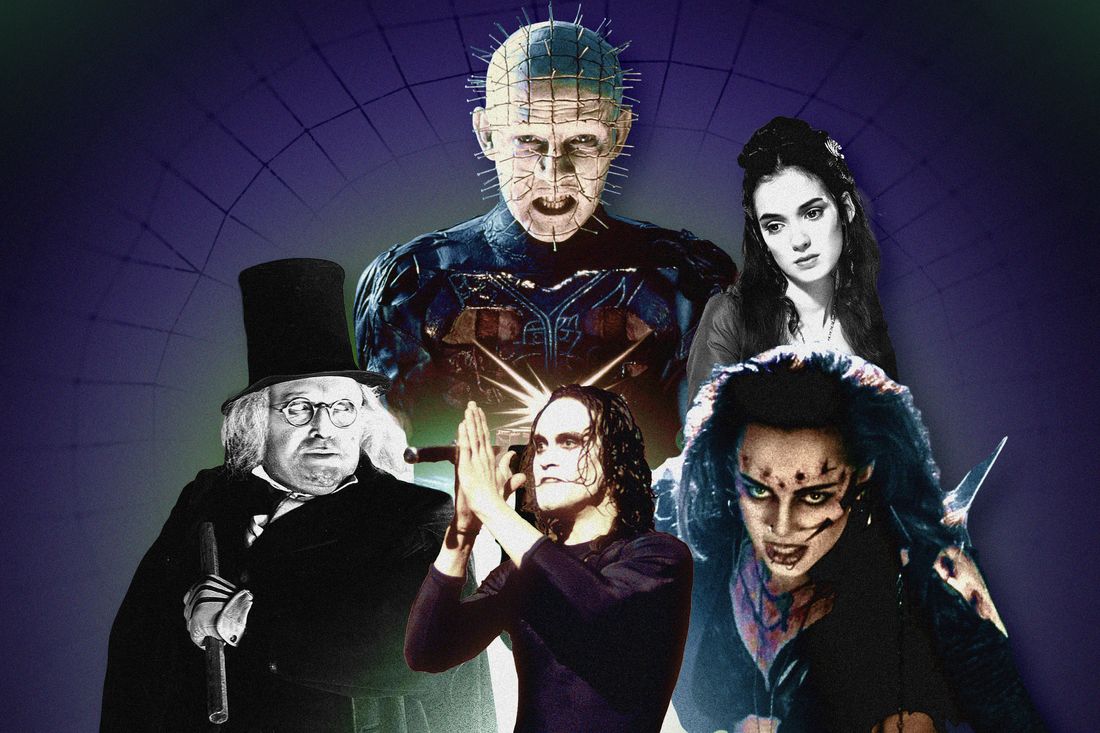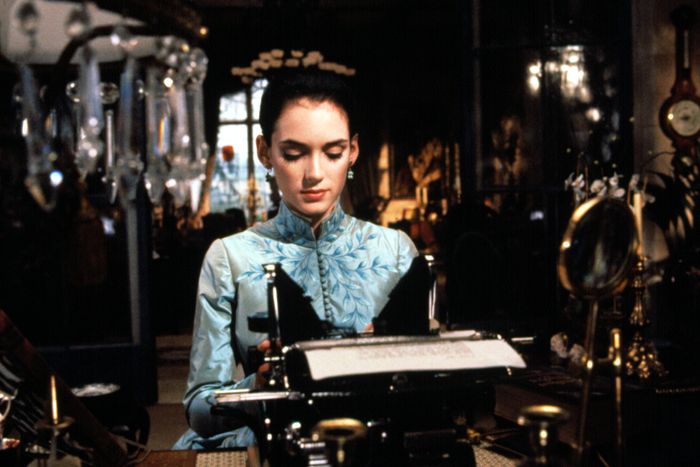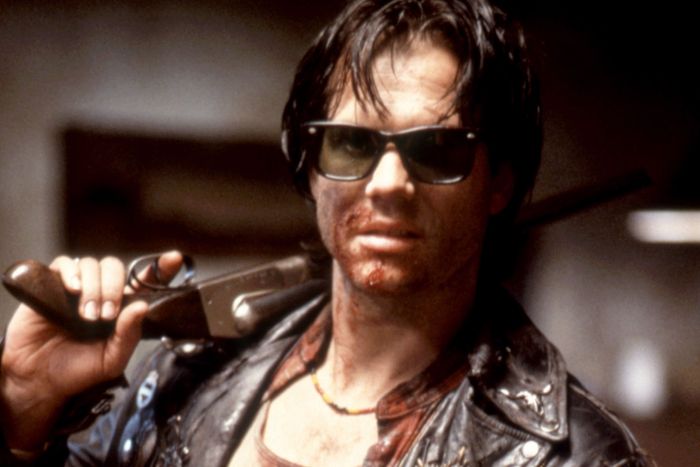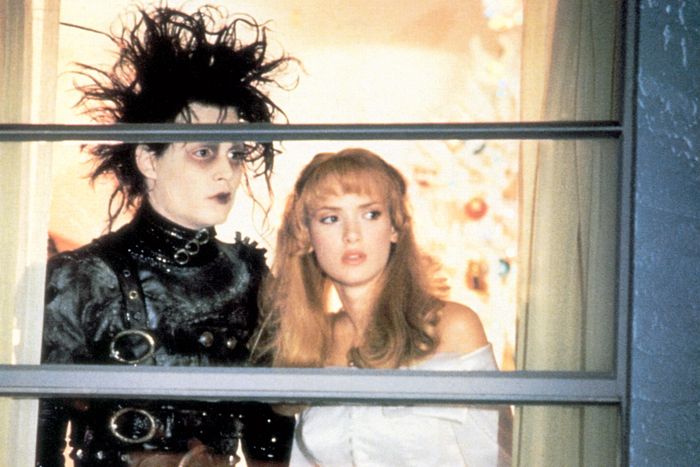
Goth is a vibe, a mood, and — thanks to many visionary directors, production and costume designers, and art directors — a cinematic subculture. And we’re not just talking about Tim Burton here. There are dozens of films that reflect goth’s ideology and aesthetic, from which one could define a goth cinema canon.
The tricky thing about goth is that because it’s a movement birthed from Gothic literature, horror, mythology, baroque art, and ’70s and ’80s bands like Siouxsie and the Banshees, the Cure, Joy Division, and Bauhaus, it often feels in conversation with other genres, overlapping with everything from vampires and haunted houses to sci-fi space operas and cannibal romances. What these all share, though, is a fascination with what’s behind the closed door, what lurks in the shadowy hallway, and the creepy-crawly-butterfly-swoopy sensation you get from both walking through a cemetery at night or realizing that you love someone else more than you love yourself. It’s simultaneously dramatic, romantic, subversive, and foreboding.
To reflect the scope of this silver-screen species, we’ve collected 25 films (we started with about 70) that reflect how depictions of goths have changed over time, and together make a portrait of the themes, visuals, and looks that define the subculture, and the subculture’s role in the counterculture. In honor of goth’s fashion-forward feeling, we’ve organized this canon by de rigueur glamor, grouping together films not necessarily by the era in which they were made but more by their fabrication flavor — the kink factor of PVC, the romanticism of crushed velvet and lace, the depraved quality of no clothes, just blood. We’re all living in one, big, dark room; might as well put a movie on.
Crushed velvet and lace
Period pieces, fantasies, and romances, movies that sound like a dusty book slamming shut and a creaky door beckoning you forward.
Bram Stoker’s Dracula (1992)
Francis Ford Coppola’s last major passion project before Megalopolis is sensual, lush, and astonishingly practically made, a movie that draws out the horror of its source material while also emphasizing elements of the groundbreaking vampire novel that might not be so obvious on first read. Winona Ryder is going to be all over this canon as Gen X’s goth princess (and yes, Heathers was on our short list), but her work as Mina Harker might be her best performance of this time; those huge eyes and her gasping breaths perfectly express her character’s restraint and sexual repression, and explain how easily she’s drawn under Count Dracula’s (Gary Oldman) spell. Everything about the film works, though — Eiko Ishioka’s costumes are unforgettable, especially Vlad the Impaler’s blood-red armor; Sadie Frost’s sex scene with wolf-form Dracula is insane; Keanu Reeves’s accent really isn’t that bad. All that collaboration and detail means Bram Stoker’s Dracula is transportive, every single time. (And if you want a better goth-Keanu performance, Constantine is right there.)
Interview With the Vampire (1994)
One cannot discuss modern goth without discussing Anne Rice’s The Vampire Chronicles novels, and one cannot discuss The Vampire Chronicles novels without discussing 1994’s Interview With the Vampire, for which Rice adapted her own novel. For the most part, Rice and director Neil Jordan stayed faithful to her book: to the characters’ dense dialogue, Louis de Pointe du Lac’s (Brad Pitt) perpetual brooding, and the sexualized menace of the Théâtre des Vampires coven and its leader, Armand (Antonio Banderas). If your goth flavor is ruffled shirts and smoldering stares, this is the film for you! (And if it’s nu-metal and ultra-low-rise bottoms on both men and women, you can check out Queen of the Damned, which adapts Rice’s second and third Vampire Chronicles books.) But the real reason to watch Vampire is a delightfully nefarious Tom Cruise, giving a gonzo performance as Louis’s maker Lestat de Lioncourt. Cruise doesn’t really do villains that often anymore, but his work as Lestat will make you wish he did.
Labyrinth (1986)
Jim Henson gave us the Muppets. He also gave us David Bowie as the glam-rock goblin king Jareth, the Byronic figure who sexually awakened a whole generation. (And if you were an adult already on the Bowie-as-goth train thanks to The Hunger, Labyrinth was a fun, aggressively cod-pieced bonus.)
Häxan (1922)
One of the earliest Ur-goth texts, the Swedish silent film Häxan is a mixture of documentary and narrative, and an attempt by writer and director Benjamin Christensen to chart centuries of the belief in and accusations of witchcraft. It’s entrancing and odd, with images and vignettes that give it the feel of a fever dream — blue-tinged Christian iconography, red-hued sequences of devils and demons, black-and-white scenes of women frolicking around babies drained of blood. So much of our knowledge of witchcraft and what we imagine when we think of witches comes from Häxan, including the suggestion that male fear was at the root of much of the aggression and violence toward accused women. It’s one of the most feminist works on this list. You could schedule this one with 1940’s Rebecca, 1961’s The Innocents, and 1981’s Possession for a great “men do really put women through some shit” marathon.
Crimson Peak (2015)
Guillermo del Toro is a way more romantic filmmaker than he gets credit for. Hellboy and Hellboy II: The Golden Army are basically “what would happen if two outsiders fell in love?” stories, and Pacific Rim’s face-off scene between Raleigh and Mako Mori is incredibly sexy. And with Crimson Peak, del Toro swings for the fences, with big gestures from English baronet Sir Thomas Sharpe (Tom Hiddleson) to prove his love for American heiress Edith Cushing (Mia Wasikowska), a big decaying mansion, and big ghost energy. It’s del Toro’s most straightforward exploration of the cost of love, especially the forbidden kind. Its characters are haunted by secrets and regrets, and motivated by a last chance for companionship — a balance that captures something integral to Gothic fiction. (If you need additional convincing, this shot of Sharpe and his sister Lucille (Jessica Chastain) wearing black-out sunglasses is as goth as it gets.)
Suspiria (1977)
Witches running a dance studio in Europe and murdering their enemies in grotesque, neon-lit sequences to a spooky whisper-and-synths score — Suspiria’s a classic! Dario Argento’s giallo horror masterpiece casts a long shadow, influencing films as varied as Nicolas Winding Refn’s The Neon Demon, Adam Wingard’s The Guest, and of course, Luca Guadagnino’s own Suspiria remake. The original is of course inimitable on its own terms. It’s a riot of color and suspense that may seem, in all its brightness, far from the black-hued goth aesthetic, but its tense feel, its spin on witchcraft lore, and the mystery-unraveling plot make the film a cornerstone of the genre. Plus, Udo Kier is here, and his spookiness automatically helps push Suspiria into goth territory.
PVC
Kinky undertones and roots in film noir and sci-fi, these offerings bend reality with the help of a lot of straps and buckles.
Hellraiser (1987)
All hail Clive Barker, a foundational goth-genre figure known for the sexual nature of his horror and fantasy writing and for directing the much-mimicked Hellraiser. Barker’s Cenobites, cosmic sadomasochists who can’t tell the difference between pain and pleasure and who blur the lines between eroticism and violence, have had an immeasurable impact on all things goth, from their fondness for PVC to their commitment to kinkiness. It spawned a franchise and a reboot, and its outfits inspired Underworld, The Girl With the Dragon Tattoo, and every mall goth you’ve ever seen. What is infamy if not that?
Dark City (1998)
Goth culture’s breakthrough to the movie mainstream came thanks to a few recurring players, among them Winona Ryder, Tim Burton (more on him later), Johnny Depp, David Bowie, Christina Ricci, and the less commonly appreciated, great Jennifer Connelly, whose perfectly goth Snow White look aided her as a spunky teen in Labyrinth and as a damsel in distress in Dark City. In Alex Proyas’s film, she plays a femme fatale singer who shares a mysterious past with protagonist John (Rufus Sewell) and gets caught up in his conflict with the trench-coat-wearing, reality-altering Strangers. Dark City works so well in part because of the specificity of Proyas’s influences, in particular Fritz Lang’s Metropolis and M. The movie highlights goth’s roots in noir, sci-fi, and German expressionism, yet also breaks free of those influences for its respectably absurd ending. And it made for a real one-two Proyas punch with its predecessor The Crow, another seminal goth film.
Batman Returns (1992)
We don’t need to keep arguing about whether Batman is a cop; we need to recognize that Batman is actually the most important goth superhero. In the ’70s and ’80s, thanks to Frank Miller and Neal Adams’s work at DC Comics, the character transitioned back into a gritty, melancholy persona more in line with his original conception, in contrast to Adam West’s zany, TV-classic version. Tim Burton carried that torch to the big screen with his massively successful Batman. But his sequel, Batman Returns, with its anarchic energy, brutalist-meets-art-deco production design, and themes of found family among society’s forgotten, is the more multifaceted goth film. We all know what Michelle Pfeiffer looked like in fetish gear as Catwoman. Let us all remember that fondly.
The Cell (2000)
Eiko Ishioka just couldn’t miss. After winning the Best Costume Design Oscar for her work on Bram Stoker’s Dracula, she delivered another set of iconic outfits for Tarsem Singh’s The Cell, a psychological thriller in which a child psychologist played by Jennifer Lopez agrees to an experimental virtual-reality process by which she’ll enter a serial killer’s mind (Vincent D’Onofrio) in order to find his latest victim. That’s a very ’90s-to-aughts premise (recall that The X-Files had a similar episode, and Kathryn Bigelow’s Strange Days is also about a kind of VR), but Ishioka’s creations give the film a timelessly nightmarish quality. We see D’Onofrio as a demon, with his hair crafted into horns; we see him as a sort of surgeon-king, in high-collared gold with a damaging pair of scissors; and we see him in a gigantic black cape with a swoop of metal across his bare chest, evoking an armored bird. Wearing PVC pants, a corset, and too many accessories? That’s goth.
The Chronicles of Riddick (2004)
The Chronicles of Riddick plays like director David Twohy and star Vin Diesel read Dune, watched Dark City, and thought, Hell yeah, let’s do some mimicry, and that is a compliment. Chronicles’ bad guys are called the Necromongers, they wear brutalist-style armor, and their thing is going around and stealing people’s souls; it might be derivative, but it’s also a very fun time. Plus, Thandiwe Newton is giving the campy performance of her life as the ambitious Dame Vaako, and her attitude (and reptilian-looking gowns) really help sell the film’s goth spin on sci-fi and fantasy.
Leather trench
These are the moody outcasts with a mission, curious about what’s on the other side of reality’s veil, and willing to lose themselves to find it.
Near Dark (1987)
1987 was a big goth-vampire year; The Lost Boys came out that summer. But while there have been many punk vampires over the years, there’s a legitimate case to be made that Bill Paxton in Kathryn Bigelow’s Near Dark, smeared with blood, wearing sunglasses inside, leaning against a wooden bar with a sawed-off shotgun held over his shoulder, and sporting a huge grin, is the hottest any man has ever looked. Consider it! He’s having a great time playing Severen, a predator and a seducer, and he gives the film an impish quality that Tim Burton would later incorporate into his goth works like Beetlejuice, too.
The Crow (1994)
Brandon Lee knew exactly what to do with his profile, his reactions, and his gaze in The Crow, the 1994 adaptation of James O’Barr’s same-named cult-classic graphic novel — the film seethes with the nuance and energy of Lee’s dual performance. It’s impossible to talk about The Crow without acknowledging Lee’s accidental death during its production, and the eerie coincidence of Lee being fatally shot during the scene when his own character is killed. That tragedy will always hang over the film like a shroud. But to focus only on that calamity is to ignore that Lee is marvelously, exhilaratingly alive in The Crow, an actor so totally disinterested in artifice that he gives the film an intoxicatingly human pull. This is a lost-love story decorated with gigantic headstones and snarling gargoyle sculptures, soundtracked by genre mainstays like the Cure and Nine Inch Nails, and complemented by a lot of black lipstick and leather. It’s goth excellence, and Lee makes it so.
Blade (1998)
The blood-rave scene. What else is there to say?
Night of the Demons (1988)
Night of the Demons walked so The Craft could run. In the former, teen outcast Angela Franklin (Amelia Kinkade) invites her peers to a haunted house on Halloween, gets herself possessed by an evil demon, and then bites off a dude’s tongue. In the latter, released eight years later, high schooler Nancy (Fairuza Balk) transforms herself into her frenemy Sarah (Robin Tunney), has sex with Skeet Ulrich, and invokes the spirit of the universe. Teen girls do have fun behaving badly in goth movies, don’t they? Night of the Demons is self-aware dreck, a purposeful horror parody that lets Amanda and her also-possessed classmate Suzanne (Linnea Quigley) drive the film’s gross-out humor with their sex and violence. It’s energetic without being too self-serious, and Angela’s fishnet-and-lace outfits are still aspirational.
The Craft (1996)
If a Gen-X or millennial woman tells you she didn’t identify with any of the four teen-girl outcasts-turned-witches in The Craft, she’s lying.
The Matrix (1999)
A film that transformed American action cinema as we know it by packing in Hong Kong influences and making oil-slick, skintight PVC the coolest look around. Pretty much every element of The Matrix has continued to impact high-concept sci-fi in the 25 years since its release: its depictions of dystopia and uprisings, its questioning of our accepted reality, Trinity’s specific brand of strong female character, all those duster-length jackets. The Matrix may seem primarily cyberpunk thanks to its lines of neon-green code and brutalist spaceships. But the film’s two most defining qualities are its romance (Neo and Trinity’s love affair both strengthens and dooms them) and its characters’ ceaseless fight for self-actualization and self-determination, definitively pushing it into goth territory.
Black-and-white stripes
Minimalist visual contrast, maximalist imagination, for German expressionists and weirdo teens alike.
Edward Scissorhands (1990)
The projects Tim Burton, Winona Ryder, and Johnny Depp worked on together in varying pairings did a lot to normalize goth, and give it a more whimsical, humorous, sometimes even family-friendly feel. Sandwiched between Beetlejuice and Sleepy Hollow is their crowning achievement, 1990’s Edward Scissorhands, which made Depp and Ryder goth’s reigning couple. The movie is like a Burton thesis statement, an ode to gentle-hearted outsiders and weird spunky girls, a visual mashup of John Waters–style kitsch and Frankenstein-like macabre, and a light satire of suburban living. All of those peculiarities would only intensify throughout Burton’s career, especially in his many continued Depp collaborations, like Dark Shadows, Sweeney Todd: The Demon Barber of Fleet Street, and even Ed Wood. Hot Topic has stayed in business for decades on Edward Scissorhands merch alone!
The Nightmare Before Christmas (1993)
It would perhaps be a little too flippant to describe The Nightmare Before Christmas as animated Edward Scissorhands, but these two are very much of a type, which makes sense, since Burton created the story and characters for the former and worked with director Henry Selick on the stop-motion film. A romance between a yearning young woman who wants more for herself and a rakish loner, set in a community that doesn’t quite understand the young man’s vision but eventually buys into his singularity — yeah, you see the parallels here. The Nightmare Before Christmas differentiates itself, though, with a number of bops, gorgeously evocative animation, and some legitimate scares; before Oogie Boogie became a Home Depot–approved lawn ornament, he was a pretty scary creepy-crawly. (Selick also directed 2009’s Coraline, a must-watch; Burton’s 2012 animated effort Frankenweenie is fine.)
The Cabinet of Dr. Caligari (1920)
One of the most significant silent films, full stop, the German expressionist masterpiece The Cabinet of Dr. Caligari molded centuries of horror, thrillers, and their goth overlaps in its image. Written by Hans Janowitz and Carl Mayer (both of whom became pacifists after their experiences with World War I), The Cabinet of Dr. Caligari (seemingly) follows Dr. Caligari (Werner Krauss), a hypnotist who uses the sleepwalking Cesare (Conrad Veidt) to murder whomever he pleases. The film’s themes are foundational to the development of goth (the tension between Dr. Caligari’s maniacal control and Cesare’s inability to fight back, the former’s crushing authority and the latter’s defeated conformity) and so too was its visual style of extreme shadow, extreme contrast, and extreme angles. Nearly every movie on this list, from The Crow to Dark City to Edward Scissorhands, is influenced by The Cabinet of Dr. Caligari in some way. Once you’ve seen it, you’ll never unsee it.
The Addams Family (1991)
When goth got cuddly. Cartoonist Charles Addams and illustrator Edward Gorey were parallel mid-century macabre artists, and while their work was stylistically different, their approaches shared unsettling bizarreness and tongue-in-cheek humor. When director Barry Sonnenfeld adapted Addams’s New Yorker cartoons and the two-season The Addams Family sitcom for his 1991 film, that black comedy is what he focused on, packing the cast with actors who had excellent comedic timing: Angelica Huston, Raul Julia, and Christopher Lloyd, and in the 1993 sequel, Addams Family Values, Carol Kane, David Krumholtz, Christine Baranski, and an inimitable Joan Cusack. All of them brought a lovable eccentricity to this story about resisting the pressure of normalcy. But it was the film’s breakout star and character, Christina Ricci’s Wednesday Addams, that became an icon of deadpan and unimpressed darkness. You don’t get Aubrey Plaza’s whole deal without Ricci, and you certainly don’t get Jenna Ortega’s spin on the character, either.
No clothes, just blood
Unapologetic and unrestrained sex and gore, presented slickly and sensually through extremely subversive tone, imagery, and characters.
Trouble Every Day (2001)
We don’t get that many erotic thrillers anymore, but leave it to perpetual rule-breaker Claire Denis to have made one of the most viscerally erotic, grotesque, and sad ones. Trouble Every Day is about a woman hungry for sex and for flesh (Béatrice Dalle), the husband who covers up her crimes (Alex Descas), and the other man (Vincent Gallo) hungry to make her his own; the film equates sexual conquest with consumption in increasingly literal and shocking ways, and uses Dalle’s remarkable performance to make a doleful point about how corruptive desire can be. That core of sadness (and, well, the gore and bitten-off body parts) make it a goth member of the French New Extremity movement — and a precursor to descendants like Luca Guadagnino’s Bones and All.
Doom Generation (1995)
Another film that, like Trouble Every Day or Night of the Demons, scoffs at the line between good and bad taste. Gregg Araki’s The Doom Generation is like if Showgirls, Thelma & Louise, and Lost Highway were all somehow fed through a WB teen-drama filter. It’s a masterpiece of queer cinema that thumbs its nose at nearly every white-suburban-American convention — heterosexuality and monogamy, the respect owed to law-and-order figures or the American flag — while also culminating in a horrific assault that reinforces exactly how stifling and violent the status quo is. Until that point, The Doom Generation isn’t dissimilar from (as Araki himself put it) “a Jesus and Mary Chain song,” a journey of nihilism and romanticism that echoes the same chosen exclusion of so many other goth classics. Plus, Rose McGowan’s haircut is pretty killer.
Return of the Living Dead 3 (1993)
Bride of Frankenstein meets Re-Animator in a delightful bit of shlock. Two bad kids fall in love, the girl dies and becomes a zombie, the guy does everything he can to protect her from the people hunting her down, and the girl learns that the only way she can curb her hunger is through extreme physical agony — you know, a typical rom-com! Just how far Return of the Living Dead 3 is willing to go (like scenes of Melinda Clarke’s Julie impaling herself with nails, glass, and metal shards until she resembles a human-sized flail) made it a video-rental-store cult classic, and an entertainingly extremist spin on Hellraiser-inspired pain-as-pleasure that defines so much of this genre.
The Hunger (1983)
David Bowie, Catherine Deneuve, and Susan Sarandon are entrancing in the erotic horror The Hunger. The film was criticized upon release for its many sex scenes, but it’s a heartbreaker for how tragically it depicts the forward march of time. There’s something so right about Bowie playing a seductive vampire, isn’t there? To think, this came out three years before Labyrinth. Thank you to Tony Scott’s directorial debut for giving us this enduring image of hotness.
More Goth Excellence
- The Tragic Romance of When the Gargoyles Turned Human for a Night
- Guillermo del Toro on the Misunderstood Beauty of Crimson Peak
- Is This Quiz Goth?







